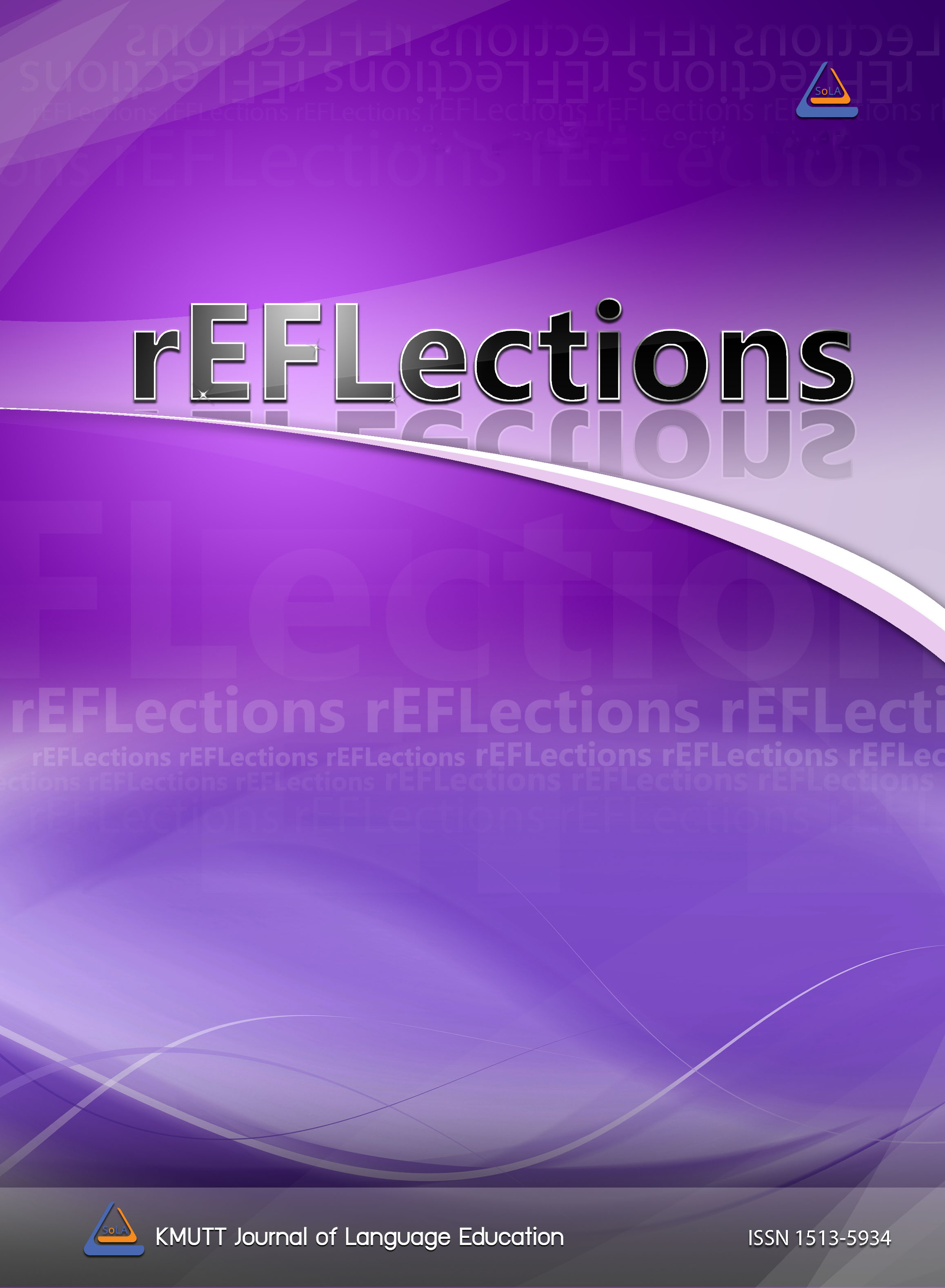A Cross-sectional Comparison of First and Second Year Thai EFL Student Writing: Syntactic, Phrasal, and Lexical Features
Main Article Content
Abstract
This cross-sectional study compares the written language of Thai EFL students in their first two years of university study. First- and second-year students (N = 170) wrote opinion paragraphs by hand in response to six prompts. Using automated textual analysis tools, clausal (subordination), phrasal (coordinated phrases and complex nominals), and lexical (AWL use and lexical diversity) measures were obtained. Matched-pairs were created by pairing different first- and second-year students from the same faculty of study who responded to the same writing prompt. The results indicated that second-year students produced significantly more complex nominals and AWL words than the first-year students with effect sizes ranging from small to medium. Implications are discussed in terms of pedagogical approaches and assessment in EFL settings, and suggestions for future research are provided.
Article Details
References
Biber, D., Conrad, S., Reppen, R., Byrd, P., & Helt, M. (2002). Speaking and writing in the university: A multi-dimensional comparison. TESOL Quarterly, 36(1), 9–48. https://doi.org/10.2307/3588359
Biber, D., Gray, B., & Poonpon, K. (2011). Should we use characteristics of conversation to measure grammatical complexity in L2 writing development? TESOL Quarterly, 45(1), 5-35. https://doi.org/10.5054/tq.2011.244483
Bowen, N. E. J. A., & Thomas, N. (2020). Manipulating texture and cohesion in academic writing: A keystroke logging study. Journal of Second Language Writing, 50, 100773. https://doi.org/10.1016/j.jslw.2020.100773
Casal, J. E., & Lee, J. (2019). Syntactic complexity and writing quality in assessed first-year L2 writing. Journal of Second Language Writing, 44(1), 51-62. https://doi.org/10.1016/j.jslw.2019.03.005
Cheng, Y-S. (2004). A measure of second language writing anxiety: Scale development and preliminary validation. Journal of Second Language Writing, 13(4), 313–335. https://doi.org/10.1016/j.jslw.2004.07.001
Coxhead, A. (2000). A new academic word list. TESOL Quarterly, 34(1), 213–238. https://doi.org/10.2307/3587951
Coxhead, A. (2011). The academic word list 10 years on: Research and teaching implications. TESOL Quarterly, 45(2), 355–362. https://doi.org/10.5054/tq.2011.254528
Crossley, S. (2020). Linguistic features in writing quality and development: An overview. Journal of Writing Research, 11(3), 415-433. https://doi.org/10.17239/jowr-2020.11.03.01
De Vleeschauwer, J. (2020). A study of the writing development, writing proficiency, anxiety, and self-efficacy of Thai EFL students. Chiang Mai, Thailand: Chiang Mai University.
Eldridge, J. (2008). “No, there isn’t’ an ‘academic vocabulary,’ but…”: A reader responds to K. Hyland and P. Tse’s “Is there an ‘academic vocabulary’?”. TESOL Quarterly, 42(1), 109-113. https://doi.org/10.1002/j.1545-
7249.2008.tb00210.x
Lan, G., Liu, Q., & Staples, S. (2019). Grammatical complexity: ‘What Does It Mean’ and ‘So What’ for L2 writing classrooms? Journal of Second Language Writing, 46, 100673. https://doi.org/10.1016/j.jslw.2019.100673
Lu, X. (2010). Automatic analysis of syntactic complexity in second language writing. International Journal of Corpus Linguistics, 15(4), 474-496. https://doi.org/10.1075/ijcl.15.4.02lu
Lu, X. (2011). A corpus-based evaluation of syntactic complexity measures as indices of college-level ESL writers’ language development. TESOL Quarterly, 45(1), 36-62. https://doi.org/10.5054/tq.2011.240859
Mazgutova, D., & Kormos, J. (2015). Syntactic and lexical development in an intensive English for Academic Purposes programme. Journal of Second Language Writing, 29(1), 3-15. https://doi.org/10.1016/j.jslw.2015.06.004
Plonsky, L., & Oswald, F. L. (2014). How big is “big”? Interpreting effect sizes in L2 research. Language Learning, 64(4), 878-912. https://doi.org/10.1111/lang.12079
Polio, C. (2017). Second language writing development: A research agenda. Language Teaching Research, 50(2), 261-275. https://doi.org/10.1017/S0261444817000015
Polio, C., & J. H. Park (2016). Language development in second language writing. In R. M. Manchón & P. Matsuda (Eds.), Handbook of second and foreign language writing (pp. 287-306). New York, NY: Routledge.
Thongyoi, K., & Poonpon, K. (2020). Phrasal complexity measures as predictors of EFL university students’ English academic writing proficiency. rEFLections, 27(1), 44-61.
Yoon, H. (2017). Linguistic complexity in L2 writing revisited: Issues of topic, proficiency, and construct multidimensionality. System, 66, 130-141. https://doi.org/10.1016/j.system.2017.03.007
Yoon, H., & Polio, C. (2017). The linguistic development of students of English as a second language in two written genres. TESOL Quarterly, 51(2), 275–301. https://doi.org/10.1002/tesq.296


